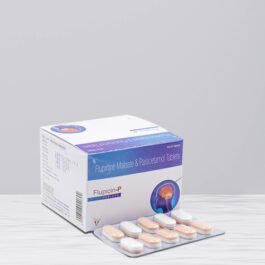STARNAC-100 / 200 SR Tablets
Definitive Management of Souring Inflammation
COMPOSITION – Aceclofenac 100/ 200 mg
Description
Aceclofenac (NSAID of BCS Class II)
- A phenylacetic acid derivative with anti-inflammatory and analgesic properties.
- Highly (>99%) protein bound possessed with poor aqueous solubility circulates mainly as unchanged drug.
- Has additional properties to inhibit the synthesis of inflammatory cytokines such as interleukin-1 (IL-1), tumor necrosis factor (TNF), and Prostaglandin E2 (PGE2).
[Note: (1) TNF may promote cancer development and progression. (2) IL-1 causes fever by affecting areas of brain. (3) PGE2 causes redness, swelling, and pain.]
Mechanism
- Its mechanism of action is based on the inhibition of prostaglandin production by selectively inhibiting COX-2.
- In contrast to some other NSAIDs, aceclofenac has shown stimulatory effects on cartilage matrix synthesis.
Management of pain and inflammation
- Improved functional capacity in adults with radiologically confirmed OA; reduced joint tenderness, swelling, and erythema, and improved knee flexion and extension.
- Reduction in pain intensity from baseline almost equivalent to its competing NSAIDs diclofenac, nabumetone, naproxen, piroxicam, and paracetamol.
- Reduces joint inflammation, pain intensity and the duration of morning stiffness in patients with rheumatoid arthritis; also effective in other painful conditions (e.g. dental and gynaecological).
Safety and efficacy
- Well-tolerated, and well-accepted therapy for both acute and chronic inflammatory and degenerative diseases.
- Better tolerated than several other NSAIDs, including naproxen, piroxicam, indomethacin, and ketoprofen.
- A tolerability profile generally similar to that of tenoxicam and paracetamol.
- Significantly lower incidence of GI adverse effects compared with other NSAIDs, which may result in lower withdrawal rates and increased treatment compliance.






